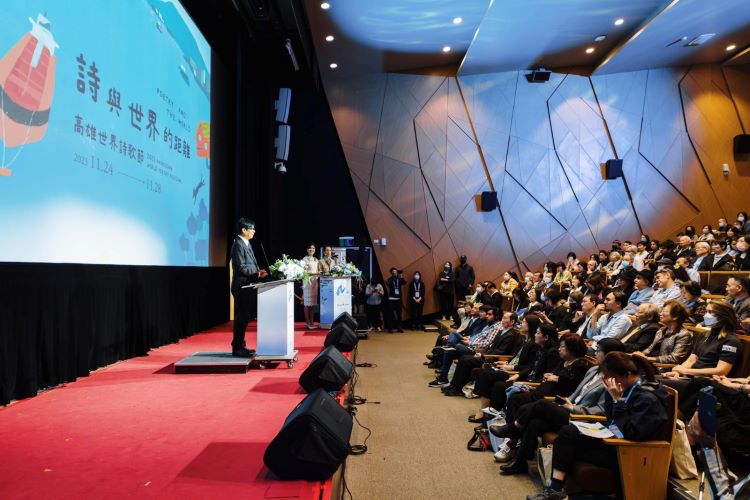
Kaohsiung World Poetry Festival has been a major cultural event in Taiwan with more than 60 poets from around the world gathering at one place
By Ashraf Aboul-Yazid
Chen Chi-Mai, Mayor of Kaohsiung City, wrote that “from Takao to Kaohsiung, this centuries-old city continues to grow. Thanks to its people’s diligence and perseverance, splendor and progress take root in the city, making it a fertile ground for culture. On this inclusive land, people work together to weave stories with their beloved city and write innumerable richly beautiful life chapters.”
These words were read during the Kaohsiung World Poetry Festival 2023 held for the first time after the merger of the Kaohsiung city and county, to showcase the city’s unique culture that blends the mountain, sea, and seaport characters and brings the city and the world closer through poetry.
As Taiwan’s biggest seaport, Kaohsiung meets all the criteria for being an important stronghold for international exchange. More than a transport hub for commerce and business, it has the potential to be a port of export for cultural and artistic exchange.
Chen Chi-Mai said: “We would love to establish a platform for exchange – especially after the restrictions for the pandemic have been lifted – one that enables poets at home and abroad to discuss their poetic thoughts and cultures so that the world can get to know Kaohsiung as she takes a step forward toward the world. Poetry is a concise type of writing. Facets of the society and the sentiments radiate from amongst the verses. We internalize the cultural meanings and imaginations as we read a poem, letting our souls reside in the tiny space created by the poem and enjoy different perspectives and delights therein.”
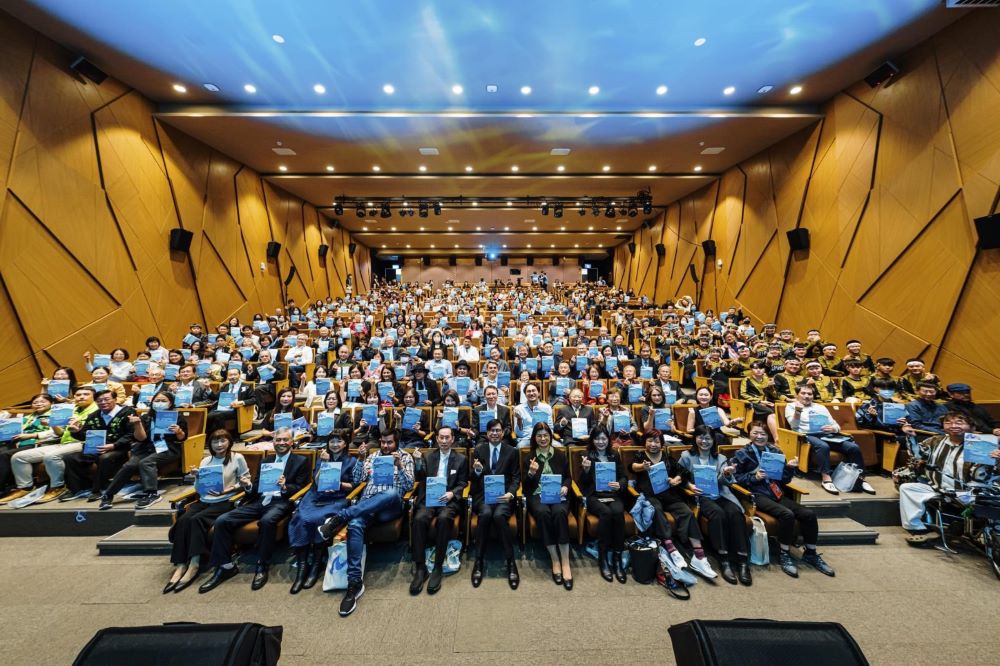
Kaohsiung World Poetry Festival has been a major cultural event in Taiwan with more than sixty poets from around the world gathering in one place, offering the poets an occasion for interaction while giving the Taiwanese people a feast of listening to the voices of poetry and the world.
Four Groups for All Seasons
I was the only Arab poet who joined poets from 12 countries, in addition to 43 poets from Taiwan, to celebrate this unique festival in its revival after 18 years of its first edition. Parts of the activities had been carried out in groups to ensure a better experience so that poets can fully enjoy their stay.
List of Poets in Group (A) were Marlene Mosquera, Augusto Rodríguez, Siomara España Muñoz, Corina Oproae, Liao Yiwu, Devesh Path Sariya, Xia Xia, Shun-Hua Tsui, Miao-Yi Tu, Tiang-Chhing Li, Kuei-Hai Tseng, Chen Kun-Lun, Min-Yung Lee, Hsi Han (Shu-Fen Peng), and Wang Chi-Jung.
I was in Group (B) with Álvaro Mata Guillé, Mariela Cordero García, Jorge Aliaga Cacho, Jeremy Paden, Tēnn Sūn-tshong, Ong Chiau-hoa, Lee Shing-Chang, Fang-Tzu Chang, Suei Lin Peng, Iong-Min Lim, Bukun Ismahasan Islituan, Salizan, Syaman Rapongan, Yan Yi-Sheng, and Hiòng Iông (Kî-Yáng Lîm).
In Group (C) there were Ryoji Asabuki, Ken Sekine, Matsushima (Kashiwagi), Masahito Matsumoto (Tendo Taijin), Toshiko Hirata, Lin Ta-Yang, Ming-hsin Jen, Chun-Hung Chen, Tzu Ping Sun, Kuo Rin, Tsai Wen Che, Wu Sheng, Maniniwei, Yu-Fang Li, Pi-Hsiu Hsieh, and Lee Chang Hsien.
In Group D there were Choi Young, KyuKim Sun He, Kang Tae Geon, Kim Sang Mi, Kwon Taek Myung, Hsing-Chieh Ling, Li Yu-Huang, Chiung-Ming Cheng, Yu Hsien (Chung-Chin Chang), Mo Yu (Liang-Ya Lin), Bûn-Chiuⁿ Chhòa, Tseng Yuan Yao, Hung Hung (Hung-ya Yen), Khîn-Hōaⁿ Lí, Sen Kim Soon, and Ching-Fa Wu.
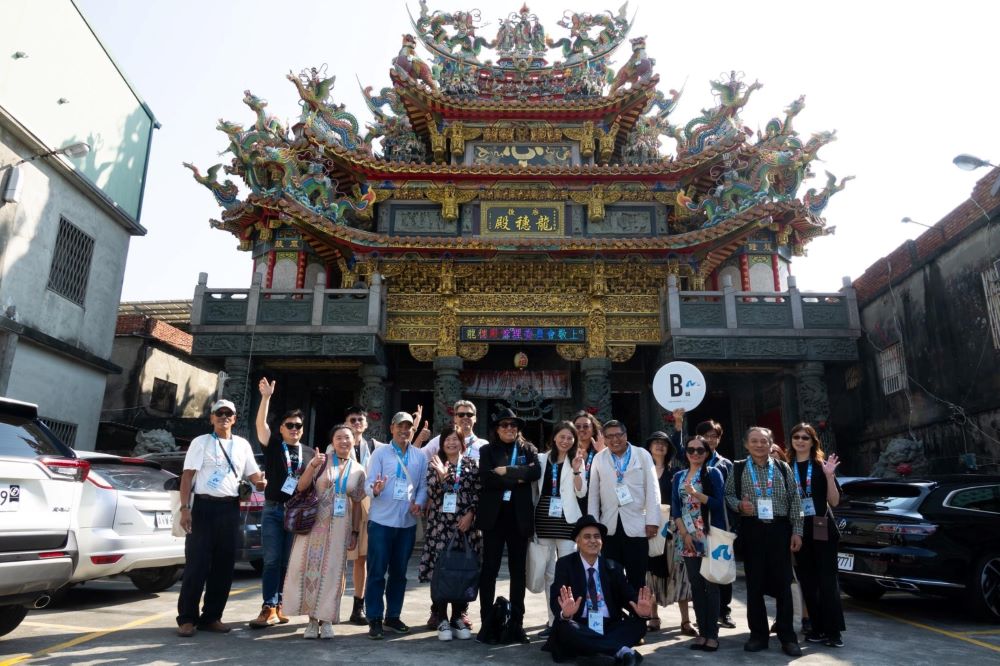
Four Hakka Poets Published in Arabic
For me, it does not seem that there is anything more representative of human history than poetry. It is true that narration has a broader horizon, greater freedom in formulation, and a more comprehensive ability to record numbers and statistics in addition to biographies and narratives. However, poetry remains the most truthful mirror as it is the voice of man himself.
The ability of poets is evident in that this voice is an echo of their nation, an embodiment of its history, and that they have carved their alphabet with the chisel of art from the stone of that legacy. Hence, I find that the Hakka poem and its poets have succeeded, together, in planting a forest of ideas that have sprouted to express the earth and man together. And the best represented by these voices in the anthologies in your hands
In this project, in which I present to the Arab reader four poetic voices from Taiwan, Du Pan Fang-ge, Tseng Kuei-Hai, Wu Ching-fa, and Fang-Tzu Chang, I aspire that my book will serve as a gateway to the vast world of this small island that holds on its land, there is a heavy history that does not lack pain and hopes.
I also translated another book of poems written by the Taiwanese poet Miao-yi Tu, entitled “They Are Siraya’s Daughters”, both books were published in Cairo in the Silk Road Literature Series.
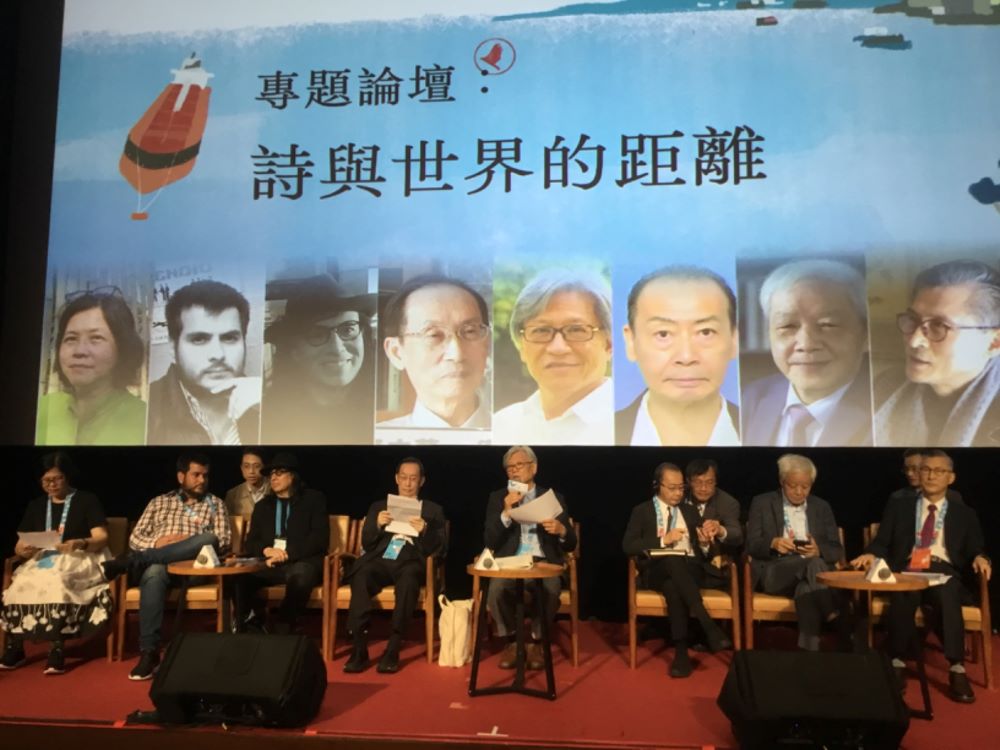
Taiwanese, Korean, and Japanese Poetry in Mini-Forums
A mini forum on “Japan and Taiwan—Spiritual Exchange between Poets” was hosted and interpreted by Ruoh-Shan Chiou, with speakers Li Yu-Huang, Ken Sekine, and Ryoji Asabuki. Another mini Forum on “Current Situation of Modern Korean Poetry” was hosted and interpreted by Sang-Ho Kim, with speakers Chiung-Ming Cheng, and Kwon Taek Myung.
In his paper, “Japan and Taiwan-Poets’ Spiritual Communications”, Dr. Ken Sekine highlighted the role of the literary magazine Mita Bungaku, published by Keio University, in introducing Taiwanese poets since the occupation era.
Also read: Kaohsiung World Poetry Festival 2023 begins on Nov 24
When wars tinually broke out in Asia, the magazine, as the forum to spread liberal literature dart played a significant role, and held the dignity of art as the most important. From then on, Mita Bungaku has introduced to the world some outstanding portant has Junichiro Tanizaki , Kyoka Izumi , and Mantaro Kubota. Roughly at the same time, Shuji Hayashi, a core member of Le Moulin Poetry Society, a group of modernist poets, became Nishiwaki’s student Keio. Born in Tainan, Taiwan, Hayashi composed many elegant Japanese poems. This is the beginning of the communications between Mita Bungaku and Taiwanese poets.
Although members of Windmill Poetry Society were either killed or scattered, and their traces of activities have gradually been wiped out in a complicated political environment, their vivid images are revived in Le Moulin, a documentary directed by Huang Ya-Li in 2017. Adopting the surrealist technique, the im reproduces the stuff preserved by the surviving family of Hayashi in hard times, and delineates painfully the communications between Hayashi and Nishiwaki. A lot of audience felt surprised about the sine interactions between poets in Taiwan and Japan in the colonial days.
On the other hand, in terms of the poets’ communications, when the documentary was released, Li Poetry, an influential Taiwanese poetry society, communicated with Mita Bungaku in 2019. Mita Bungaku introduces Taiwanese poets such as Lee Kuei-Shien, Lin Feng-Ming,Li Yu-Fang, Hsieh Pi-Hsiu, Lee Chang-Hsien, Cai Rong-Yong, Lin Lu, Chen Ming-Keh, Chen Hsiu-Chen, Yang Chi-Chu, while Li Poetry Magazine introduces, in one issue after another, Gozo Yoshimasu, a poet and the chairperson of Mita Literary Society, and the poems of Takahiko Okada, Ryoji Asabuki, Hitoshi Kawamura, Kaoru Soeda, Toru Sugimoto, Eisuke Wakamatsu, Shuhei Yamazaki, Yuki Nagae, and Erina Oka, the deputy editor-in-chief of Mita Bungaku. In addition to Mita Bungaku, Kokusho Publishing Association published Taiwanese Modern Poetry Series in three volumes (2002-04), including the translated poems by ten poets such as Lee Kuei-Shien, Jiao Tong, and Yang Mu.
Ken Sekine is a PhD in literature, editor-in-chief of Mita Bungaku, professor emeritus in Keio University. In that university he was the chairperson of literature department, professor, assistant professor; he was also a visiting scholar in Oxford University. He publishes Literature of Resistance-the Literature and Life of Abo, an Officer of National Revolutionary Army; The Appearance and Reality of Modern China; Breaking Away from the Norm. He translates The Illusion of the Peach Blossom Spring; Nanking-Resistance and Dignity; Our Youth, in Taiwan. He concluded his paper: “With the deterioration of the global political tension, Taiwan has endured great pressure from Mainland China across the strait, while many things have become more and more important. However, no matter how political environment may change, Mita Bungaku hopes to walk with Taiwanese people and to bear as a friend the fate of Asia together. We will strive to be the media, which faithfully conveys the poets’ voices to maintain the human dignity. We sincerely hope that you can support and spur Mita Bungaku on.”
The Observations on Asian Poetry
With Taiwan, Japan, and Korea as the focus, modern poetry must not be restricted by regions; it belongs to the whole world. It should be the goal to Asian poets to combine the universal characters with regional features and to search for the development of modern poetry.
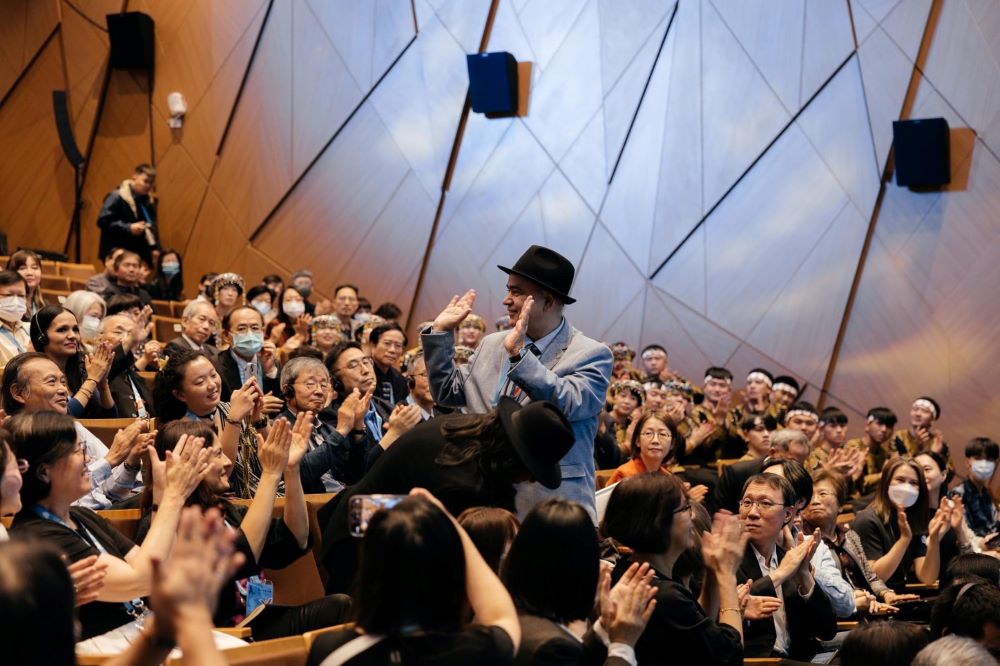
How did the communication of Asian poets start? Dr. Kim Sang Ho, Korea, gives us an answer: “According to Kim Kwanglim (1929) and Tân Tshian-bú (1922-2012), when Tan and his wife went to Japan on March 1977, they met Kim in Seoul for the first time. While they were visiting Gyeongbokgung in Seoul, they talked in details about the creation and development of modern poetry. It is worth mentioning that Kim conceived the editorial and publication program of Asian Modern Poetry. Tân highly appreciated this program; therefore, Kim asked Tân to discuss the publication of Asian Modern Poetry with Yuta- la Akiya (1922-2008) and Kikuharu Takahashi (1926-2006) in Japan. When Tån arrived in Japan on the same day, he came out with a concrete plan for the publication while meeting Takahashi.”
Dr. Kim Sang Ho explained more: “Korea and Taiwan were both colonized by Japan, deprived the right of using their ethnic languages, and forced to adopt the Japanese language. What pain did this fact bring to the two countries? The East Asian poets communicated with poetry and literature, while they might hate the Japanese language, which they could not shake off. Tân and Kim, who had been persecuted by Japan, transformed the negative experiences of using the Japanese language to the love of their native tongues and to their self-affirmation. Their painful memories about the Japanese language were changed to the glorification of their native tongues.
As Dr. Kim Sang Ho wrote; the positive significance of the communications of Asian poets lies in the encounter and mutual learning of modern poets, who came from different language systems and who expressed with different languages; consequently, they might reflect on their own languages and then uphold the tradition of their national poetry. Moreover, it may transcend their own thoughts and individual perspectives. They may promote modern Asian poetry and literature with equality, peace, and kindness. He gave us these subtitles in his observations on Asian poetry:
Asian Poets Conference
The Earth Poetry Society held “Tokyo International Ports Conference” on November 23-25, 1980. Later on, Li Poetry Club and Taichung Cultural Center held “The Association for Taiwanese, Japanese, and Korean Poets” in Taipei on November 14-17, 1982. This was meant to commemorate the publi cation of Asian Modern Poetry, Vol. 1, and it initiated the Asian Poets Conference. The hot discussion can be imagined when poets from three countries gathered, a situation that transcended the boundaries between their languages and nations. The conference was held by Tin, Kim, and Akiya. Poets like Pai Chin ([1937-2023]) and Kikuharu Takahashi attended this conference, and there were 67 participants.
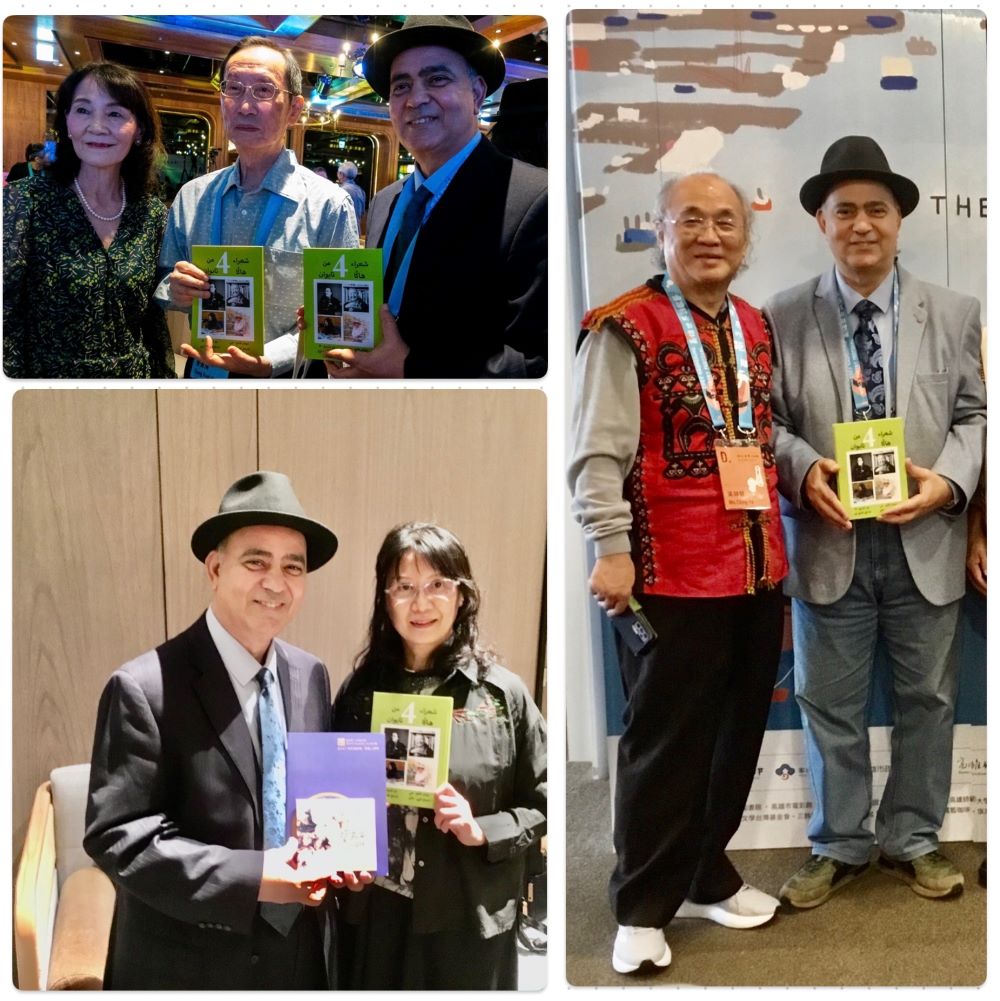
“The 95 Asian Poets Conference (the fifth session)” was held in the Sun-Moon Lake Teachers’ Hall, located in a scenic spot in central Taiwan, on August 24-28, 1995. The theme of this conference was “the poetry and literature toward the 21″ century,” meant to explore the prospective of Asian cultures and literature; the themes were divided into two subtopics: “challenge and response,” “the light and shadow of Asian poetry.”
The Book Exhibition of Eastern Asian Poetry
Although Asian Modern Poetry has been published to the sixth volumes, the most significant is the demonstrations of the poets’ unique poetic world and of the features of modern poetry in all countries. It displays the panoramic view on modern Asian poetry and its possible development. After 1996, the Asian Poets Conference has not been held in Taiwan, Japan, and Korea, nor has Asian Modern Poetry been continually published. Thence, owing to the discussion by Tân, Kim, and Souji Yamaguchi (1934-), Taiwan, Japan, and Korea take yearly turns to hold the Book Exhibition of Eastern Asian Poetry. This Book Exhibition has been held to 2006. After the ninth session of the Book Exhibition of Eastern Asian Poetry, poets in Taiwan, Japan, and Korea have not communicated for nearly seven years.
The festival of Asian poetry
With the communicative spirit of modern poetry in Taiwan and Korea, Dr. Kim Sang Ho has promoted, since November 2012, the festival of Asian poetry held in the coffeehouse of the official residence of Taipei Mayor. Taiwan and Korea have taken yearly turns to hold it to the seventh session in 2019. Afterwards, because of COVID-19, it was not held until 2022, while the eighth was held in Seoul in October.
The themes of Taiwanese poetry
Beginning with the emergence of the new poetry movement in 1923, modern Taiwanese poetry, inheriting the tradition of realism, has been closely associated with social reality. The pre- and post-war poets all intentionally expose the robustly existential consciousness of life and reality, projecting various aspects of contemporary reality and society.
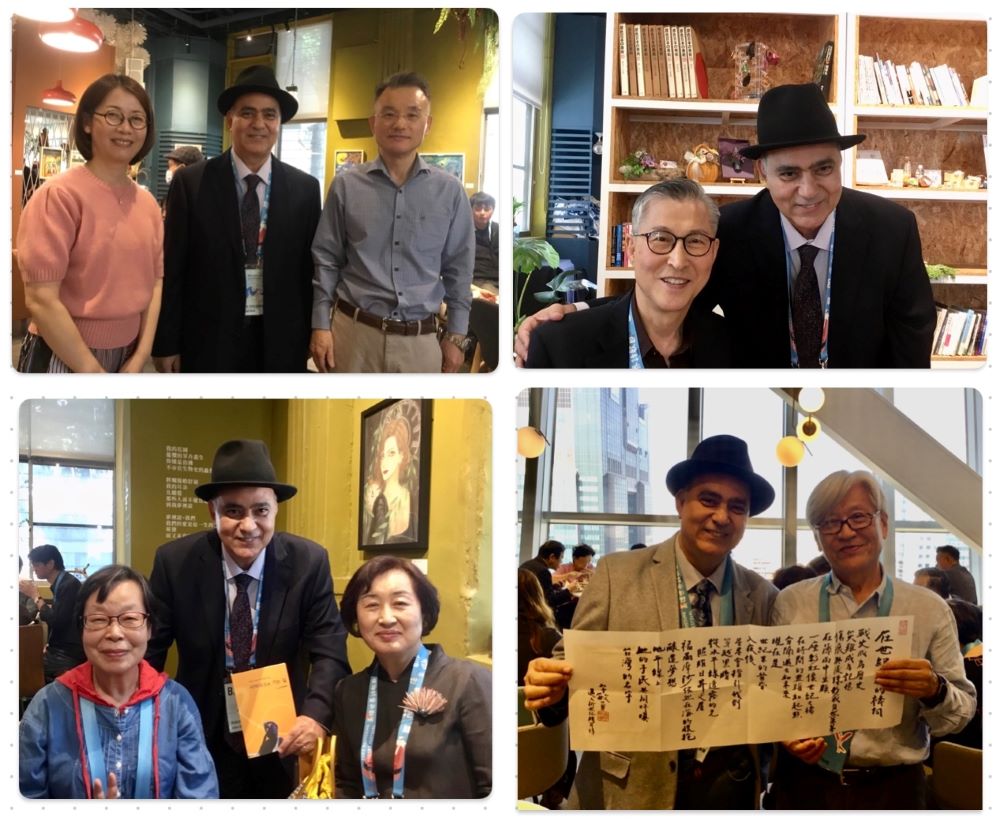
In the 70s, the realistic poetry can be seen into two different types. One focuses on the reality “right here,” while the other on that “over there.” The former comes from the indigenous writers and the latter from these coming from Mainland China to Taiwan. For the former, they suffered in their life spare, and therefore aesthetics could be luxurious; for the latter, the instrumentalism of poetry renders the existence of poetry problematic. The former relied on the down-to earth reality, while the latter “treated nostalgia as the reality.” For the former, the latter displayed “escapism.”
The themes of Korean poetry
In Korea, the new poetry from 1910 to the early 1920s rejects fixed forms produced by the advanced thoughts in the early modem period with the form of prosaic poetry. The 1920s saw the emergence of Korean modern poetry. The 1940s meant a historical transition, a time when poets struggled to preserve de Korean language because of the destructive language policy of the Japanese imperialism; poets in the 1950s turned to modernism and composed patriotic pieces, attempting to resist the destruction brought by the Korean War.
In the 1960s, with the impact of April Nineteenth and May Sixteenth Events, which changed their national fate, poets accepted the renaissance of life force and traditional lyricism-this was a turning point in the history of Korean modern poetry. Poets in the 1970s encountered the indifferent separation and unfair treatment with their original conception and form. The 1980s Korean is termed “a storm in the poetic circle,” a time that can be divided into two stages: in the former period, politicized literary magazines flooded; in the latter, with the prevalence of liberalism, many people believed that the political situation had been ameliorated, and it was indeed so. From the 40s to the 80s, two milestones are found in the history of Korean modern poetry: one was the anti-realistic political standpoint, while the other was self-ignorance and blindly yielded to aesthetic resistance. Poetry in the 1990s are destroying the antagonistic conflicts brought by the two opposing forces the poetic circle, anticipating the marvelous harmonic syntheses.
The themes of Japanese poetry
In Japan, “as to the history of the formation of modern poetry, on the one hand, it fought against the “seven-and-five-syllable meter,” and it is also the history of the transformation of form and language. On the other hand, modern poetry was the subject of the formation of the poet’s unbreakable modernity; it is the history to acquire modern intellectuality from the poet’s inner reality.
The former has gained pretty good results after the oral free verse movement in the middle Taisho Era. The latter transplanted European avant-garde art and initiated in Japan modernism, futurism, Dadaism, hyperrealism and many other movements; it lasted and flourished from the middle Taisho Era to the first decade of the Showa Era.”
Deriving from the “New Poetry movement, which required the singing of new voices in the Meiji Era, the modern poetry was born and heard in all walks of life: The New Poetry movement has lasted for 110 years till now, from the Meiji, the Taisho, to the Showa Eras; needless to say, it reflects profoundly the styles of various ages. The post-war Japanese modern poetry has turned into a brand-new stage, characterized by the inheritance of and resistance against the pre-war tradition of poetry.
Related report: Bridging the Distance between Poetry and the World
Dr. Kim Sang Ho summed up his conclusions: “In East Asia, despite the long-term cultural communications and mutual influences, various geographical factors and social reality have engendered heterogeneous cultural ecology. Except Japan, modern East Asia has lagged behind Europe and the United States, predominated and exploited universally by colonialism inside and outside the area. After the Second World War, countries in this area mostly became liberated, independent, and democratic; such a process may or may not be smooth, and consequently their achievements may vary. Undeniably, the development of Asian modern literature is universally under the influence of Europe and the United States, but it becomes a great challenge for Asian poets to catch up with the western pace and to maintain the unique eastern features. Although they speak various languages, Asian poets love peace more than their nationality, ideology, and race. In the age of modern industrialization, poetry itself must play a cultural role and explore the ways to contribute to human beings and society. International society becomes more and more complicated, and modern poets must strive for this contribution. In terms of literature, the growing Asian poets usually accepted prematurely the impact of the dominant colonial culture or of their contemporary hegemonic European and American cultures; they un- consciously lose the confidence on their native cultures. Despite the various conditions in Asia, Asian poets have experienced similar emotional and spiritual depression, frustration, and hope. Their purity and astuteness may bring enlightenment for the future.”
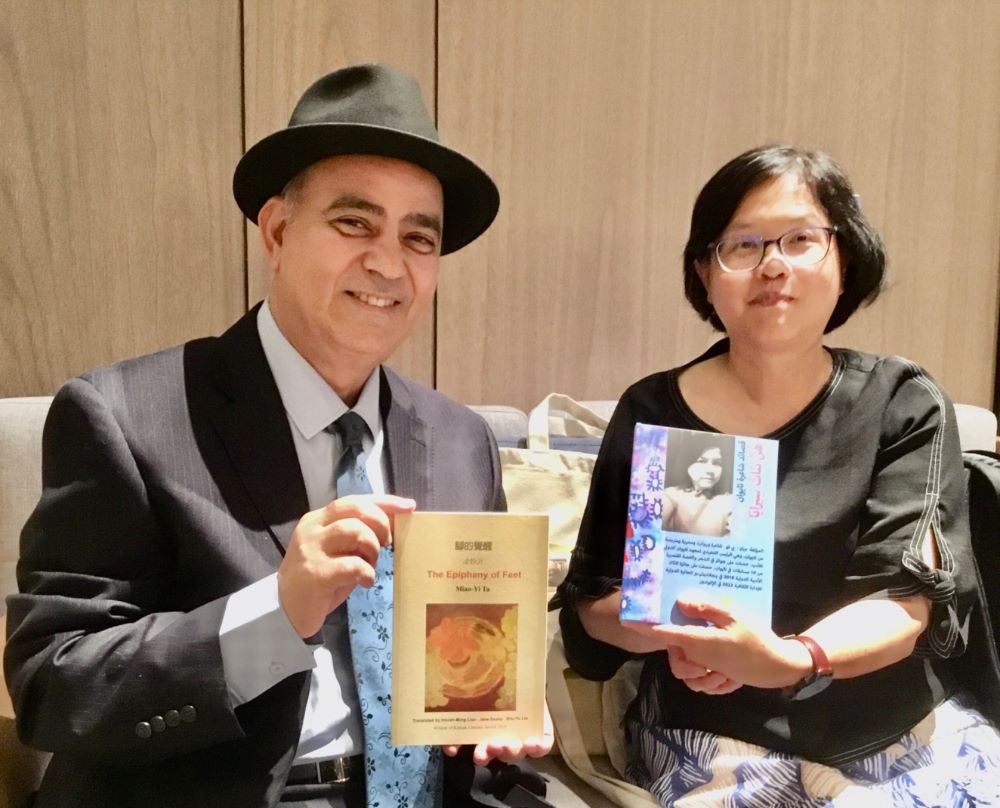
Perspectives and Opinions on the Current Korean Modern Poetry
Korean Poet Kwon Taek Myung, secretary, chairperson of communication in Korean Poetry Association; now review committee member of the same organization, contributed with his own perspective and opinion on the current state of Korean modern poetry.
In the first main forum held during Kaohsiung World Poetry Festival 2023, Kwon Taek Myung recalled his participation in the previous Kaohsiung World Poetry Festival held in 2005.
He said that South Korea is ‘a country of poetry. It is hard to measure this statement in terms of quality, but it’s fair to say that it’s true, both traditionally and in terms of the number of poets and how popularity poetry has become today. I do agree with him, in our Middle East countries each and every citizen could state the same sentence referring to his own country!
But Kwon Taek Myung has his own reasons; first of all, in Korea’s major newspapers, works of lyric poetry with brief comments by poets or literary critics are published on a weekly basis. Additionally, subway screen doors are densely adorned with poems written by poets as well as poems written by citizens that were selected through competitions.
In terms of the quantity of poets, even the Korean Poets Association, of which Kwon Taek Myung belongs to and the oldest and most established organization in Korea has about 1,500 members as of 2022. Considering the membership of the Korea Modern Poets Association, another nationwide organization of poets, as well as poets who have chosen not to participate in these groups, it can be said that a significant number of poets are actively engaged in the field.
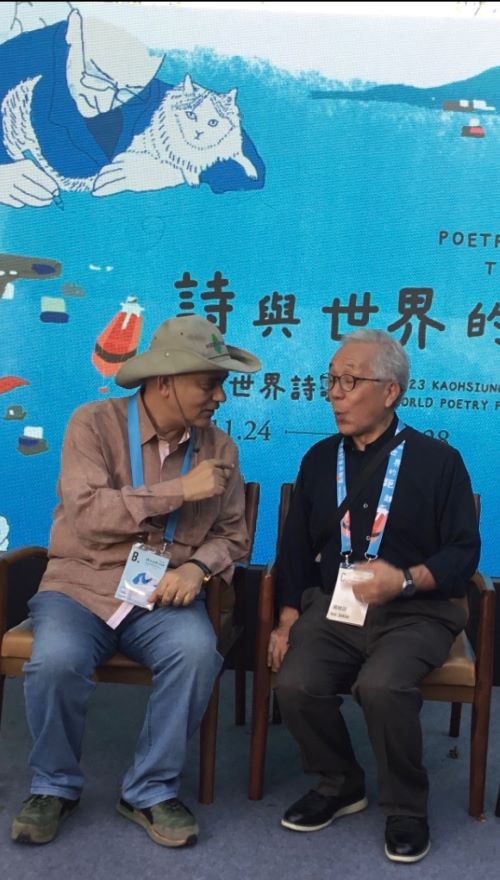
One mutual aspect of similarity – between Korea and our region – is the several poetry awards given out each year, and numerous poetry collections are published. Poetry magazines and books provide opportunities for poets to showcase their work, fostering the emergence of new talents. However, with the rise in poetry publications, there are concerns about maintaining the quality of the published poetry.
I surprised Kwon Taek Myung when I gifted him my book in Arabic, a translation of love poems written by great monk, resistance icon and poet Manhae, whom I won his Grand Prize in Literature in 2014.
Kwon Taek Myung noted that modern Korean poetry can be traced back to Chai Nam-seon’s “From the Sea to the Boy,” published in 1908 on the magazine named “The Boy”, creating the so-called “New-type Poem(Sinchesi)” genre of poetry. Since then, modern Korean poetry has continued to evolve and thrive, shaping the vibrant Korean poetry we see today.
In addition, it might be worth noting that starting in 1987, “The Korean Poets Association’ and ‘Korea Modern Poets Association’ have celebrated “Poetry Day” on November 1, which celebrates the day when the first magazine “The Boy” was published in Korea. Nowadays, modern Korean poetry encompasses a diverse spectrum and range of styles. When looking out the current situation of Korean poetry, Kwon Taek Myung said, it will be easier to describe it by dividing into several sections. Regarding the current trend of modern Korean poetry, poetess Han Young-ok says: “If we look back at the lyrical and ideological orientation of the 1920s, the confrontation between so-called pure poetry and modernism in the 1930s, and return to the lyrical and ideological orientations of the modem 1950s, as well as the later modernism, it can be said that the world of lyrical stand d ideological orientation of modern Korean poetry and the traces of influence by modern Western poetry have led the subsequent divergence and flow.”
Then she introduces the description by Kim Chun-soo, a successful modernist poet and critic born in 1922 has categorized the modern Korean poetry in terms of four “colors; (1) traditional lyric poetry, (2) physical (object) poetry, (3) poetry with a strong message, and (4) modernity and late modernism poetry (modernism and postmodernism)
While it may be challenging to categorize the diverse works of poets into broad categories, it can be said that, even as a convenient classification, the current landscape of Korean contemporary poetry exhibits variations within the mentioned categories. The first category mentioned by Kim Chun-soo, “traditional lyric poetry”, continues to be the prominent backbone of modern Korean poetry.
While the realm of lyric poetry can be considered the essence of all poetry, it also aligns well with the temperament and inclination of Koreans, who are known for their sentimental nature and deep emotions. Despite being labeled as “traditional,” it is not inherently past-oriented as it has continuously pioneered new poetic territories, such as the image-oriented “New Lyricism” movement. Currently, there is a growing trend of exploring extremely short forms of lyric poetry, known as “Extreme lyric poetry”.
Poets, like any other individuals, cannot exist outside the context of their time, history, and environment, and in the case of Korean modern and contemporary history, it can be said that – according to Kwon Taek Myung – Korea has gone through several turbulent periods, such as Japanese colonization, government establishment, the Korean War, industrialization, and democratization, and is now facing the challenge of further advancement and progress to be a leading country. Poets, with their unique sensitivity, have the ability to perceive and diagnose the times and life itself. That is why they are often regarded as visionaries and prophets
In conclusion, Kwon Taek Myung believes that “there are several areas in which modern Korean poetry should be deeply taken into consideration for the following items: (1) the issue of potential decline in quality of published poetry, (2)comparing to the increase of poets and popularization of poetry, (3) unnecessary esotericism, (4)the overflow of micro-discourses on personal affairs following disappearance of the macro-discourse in the wake of the democratization, (5)the alienation between poets and readers due to the excessive experimental poetry, etc., influenced by postmodernism, (6) necessity of preparation for future unification poetry (literature), and (7) the importance of fostering interest in and contributing to world literature through translation and expanded international exchange, etc.”
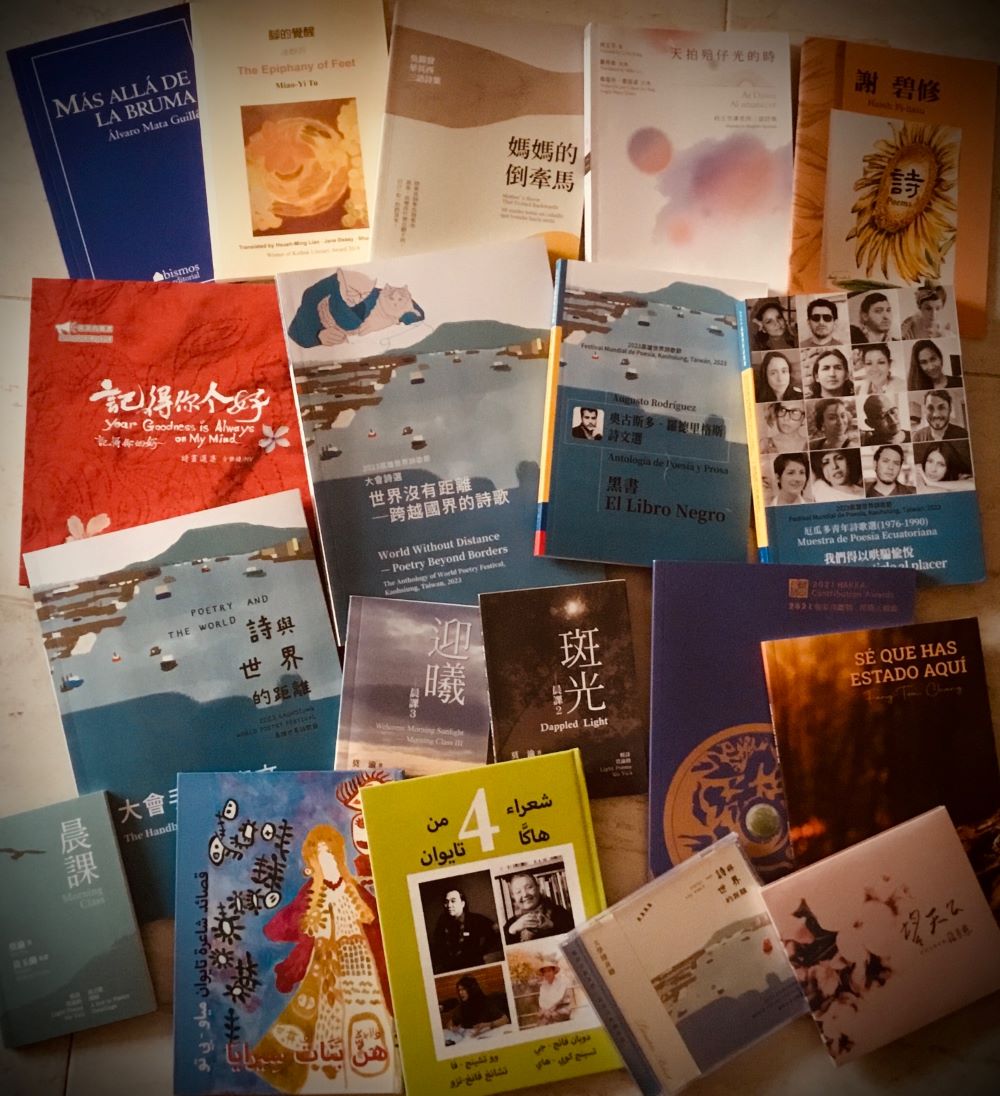
Exchanging Books Festival
Along with the main event Kaohsiung World Poetry Festival, there was a parallel festival, organized by poets themselves, where they gifted their own works in different tongues to each other. The main books came from the organizers; The Handbook and Proceedings of papers in Taiwanese, Japanese, Korean, Spanish and English, World Without Distances – Poetry Beyond Borders (The Anthology of World Poetry Festival, Kaohsiung, Taiwan) of poems written by 63 poets, Muestra de poesia ecuatorina (1976-1990) by Augusto Rodriguez), and Antologia de poesia y prosa (El libro Negro), by Augusto Rodriguez.
I also had the great chance to get these books signed by their authors: Mother’s Horse That Trotted Backwards (by Ching-Fa), The Epiphany of Feet (by Miao-yi Tu), Your Goodness is Always on My Mind (by Peng Suei-Lin), Taiwan (by Hsieh Pi-hsiu), At Dawn, Mandarin-English-Spanish collection (by Li Yu-Fang), Mas Alla De La Buma (by Alvaro Mata Guille), Se Que Has Estado Aqui (by Fang-Tzu Chang), Morning Class, Dappled Light, Welcome Morning Sunlight – Morning Class III (Three books by Mo Yu), along with a manuscript of poems by Pai Chiu, and a nice poem in calligraphy by Korean poet Lee Min Yung . I also had the chance to give copies of my translated works, in Korean, English, Sindhi, Russian, Persian, German, Turkish, Spanish, and their Arabic versions to some poets and educational institutions, as well.
_______________
Ashraf Aboul-Yazid is a renowned Egyptian poet, journalist, novelist, travelogue writer and translator. He is author of around three dozen books and Editor-in-Chief of Silk Road Literature Series.